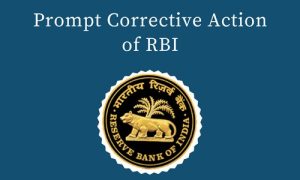03 Nov RBI’s Prompt Corrective Action for Banks: Revised (GS 3, Economics, The Hindu, Indian Express)
News/Context: The RBI on Nov 2, 2021 issued a revised Prompt Corrective Action (PCA) framework for banks to enable supervisory intervention at “appropriate time” and also act as a tool for effective market discipline. Capital, asset quality and leverage will be the key areas for monitoring in the revised framework, the RBI said. The revised PCA framework will be effective from January 1, 2022.
Objective : The objective of the PCA Framework is to enable Supervisory intervention at an appropriate time and require the Supervised Entity to initiate and implement remedial measures in a timely manner, so as to restore its financial health. The PCA framework is also intended to act as a tool for effective market discipline. The central bank also stressed that the PCA Framework does not preclude the Reserve Bank of India from taking any other action as it deems fit at any time, in addition to the corrective actions prescribed in the framework.
“Indicators to be tracked for capital, asset quality and leverage would be CRAR/Common Equity Tier I Ratio, Net NPA Ratio and Tier I Leverage Ratio, respectively,” according to the revised framework. Breach of any risk threshold may result in invocation of the PCA. If a bank is put under the PCA, several restrictions are placed on it. The framework also details conditions for exit from PCA and withdrawal of restrictions. The restrictions are imposed on dividend distribution and remittance of profits, bringing in the capital (in the case of foreign banks), branch expansion, and capital expenditure. The framework was last revised in April 2017.
What is PCA? Prompt Corrective Action Framework refers to the central bank’s watchlist of weak banks. The regulator imposes restrictions like curbs on lending on such banks. The PCA Framework applies only to commercial banks and does not cover cooperative banks and non-banking financial companies.
When exactly does a bank fall into this list? The RBI has specified certain regulatory trigger points with respect to three parameters, i.e., capital-to-risk weighted assets ratio (CRAR), net non-performing assets (NPA) and return on assets (RoA) for the initiation of the process.
If Capital goes down : There are various stages.
If CRAR falls to less than 9 percent, the RBI asks banks to submit a capital restoration plan, restricts new businesses and dividend payments. The RBI also orders recapitalisation, restrictions on borrowings from the inter-bank market, reduction of stake in subsidiaries and reduction of exposure to sensitive sectors like the capital markets, real estate or investments in non-statutory liquidity ratio securities.
If CRAR is less than 6 percent but equal to or more than 3 percent, the RBI could take additional steps if the bank fails to submit a recapitalisation plan. These measures include bringing in a new management/board, appointing consultants for business/organisational restructuring, taking steps to change ownership and also initiating the process for merger of the bank.
If CRAR is less than 3 percent, in addition to the actions upon hitting the first and second trigger points, closer monitoring and steps to merge/amalgamate/liquidate the bank or impose a moratorium on the bank, if its CRAR does not improve beyond 3 percent within one year or within such extended period, will follow.
If net NPAs shoots up: If net NPAs rise beyond 10 percent but are less than 15 percent, a special drive to reduce bad loans and contain the generation of fresh NPAs begins. The RBI reviews the bank’s loan policy and takes steps to strengthen credit-appraisal skills. Subsequently, the follow-up of advances and suit filed/decreed debt starts. Also, the RBI puts in place proper credit-risk management policies and will reduce loan concentration. Further, there will be restrictions on entering new lines of business, making dividend payments and increasing its stake in subsidiaries.
If net NPAs shoot up above 15 percent? In addition to the actions upon hitting the initial trigger point, the bank’s board is called for discussion on the PCA.
If Return on Assets (Profit) goes down: If RoA is less than 0.25 percent, restrictions on accessing/renewing costly deposits and CDs kick in and the RBI bars the bank from entering new lines of business. The bank’s borrowings from the inter-bank market, making dividend payments and increasing staff will be restricted.
Md Layeeque Azam, Economics Faculty
Plutus IAS Current Affairs Team Member




No Comments